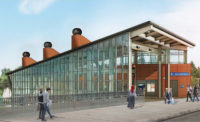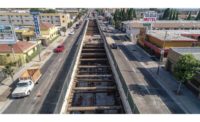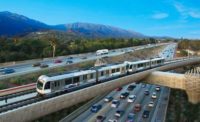By comparison, stations were assembled on site for the starter line and the southeast extension.
Construction on the northwest extension is expected to be completed by the end of the year and to become operational in early 2016.
All About Community
Construction on the Valley Metro light rail system is funded through federal transportation grants and a tax measure passed by Maricopa County voters. Both extensions brought heavy construction to areas that are among the most densely populated and trafficked in the metropolitan area. As a result, all shareholders, including owner Valley Metro, host cities and construction teams, demonstrated a commitment to the community that extended beyond what is seen on most public or private projects.
"We had a community coordinator on this job before it even began," Miller says.
Both the central Mesa and northwest extensions worked far out ahead with scheduling and took the extra steps of informing businesses and residents when road and driveway closures as well as any other access issues were to be implemented.
Additionally, regular community meetings were held to maintain open lines of communication. Once construction commenced, team members continually advised residents and businesses along the entire alignment when any work was occurring within their general surroundings.
"Communications extended to notifications on traffic restrictions, waterline shutdowns and general project updates," says Spencer Cruse, operations manager, track projects, at Kiewit. "Monthly community advisory board meetings tracked our progress."
Water shutdowns are of particular concern during the summer months in the Southwest, and Miller says the project team worked with the city to allow for shutdowns on the northwest extension during the hotter periods of the year as long as water was provided to residents.
On the central Mesa extension, Cruse says a moratorium was put in place on construction in the historic downtown from Country Club Drive to Centennial Way from Oct. 1 to April 30.










